Bread may well be the staff of life, but the
real stuff of life is carbon. Carbon is present in every known life form
on earth (it is the second most abundant element in your body, after oxygen,
amounting to about 18%). What makes carbon so interesting is that exists in
several forms, depending on the arrangements of the carbon atoms within a
substance.
 |
| Pencil |
Graphite, for example, is carbon with the atoms connected in flat
planes; it is black, opaque and soft, and is commonly found in pencils (which,
despite the name, are not made of lead). Indeed, graphite gets its name from
the Greek word γράφω – grapho, ‘to write’, the root of such words
as graphology, autograph or biography. The atomic structure of graphite means
that the soft planes can easily be deposited onto a surface like paper –
imagine it like slices of bread in a sliced loaf, as each slice it taken away,
it is replaced by the next, identical, slice that lay below it. The properties
of graphite mean that it has a great many practical applications, from pencils,
car brake linings, dry lubrication, metal casting moulds and batteries.
 |
| Coal |
In
another form (or allotrope), amorphous carbon is found in coal, soot and
other impure forms – carbon takes its name from the Latin carbo –
meaning coal. The atomic structure of amorphous carbon can be stabilized
by terminating the dangling-п bonds with hydrogen, producing hydrogenated
amorphous carbon (hydrocarbons), which are found in crude oil and petroleum
derivatives, certain waxes, and gases like methane, propane or ethylene.
A
third allotrope of carbon occurs when the atoms are arranged in a face-centred
cubic crystal structure – diamond. From the Greek αδάμας – adamas,
‘unbreakable’, diamond is known as the hardest material commonly available,
it rates 10 on the Moh’s scale of mineral hardness, and is used commercially in
diamond knives, saws and cutters, as well as a gemstone.
 |
| Moh's Table of Hardness |
The earliest diamonds
were found in India, with a smaller number of stones discovered in Borneo, and
in Brazil in 1727, with more found in Africa from 1867, the first being the
Eureka diamond.
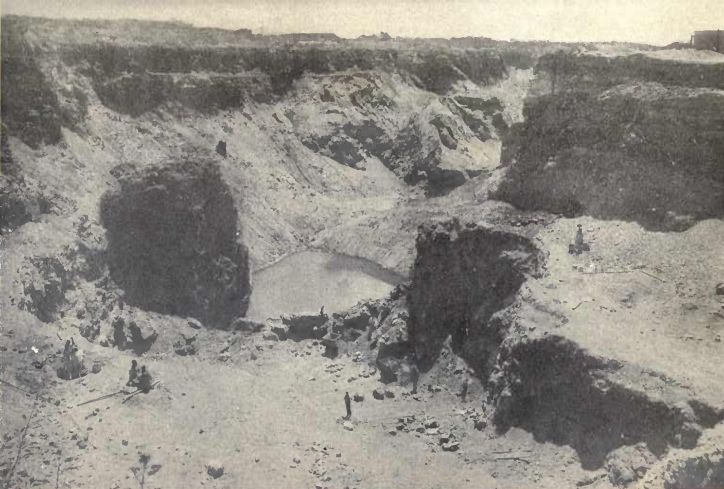 |
| The Open Mine at Kimberley |
The African diamond rush began in 1870, when a 50-carat stone
was found on a Jagersfontein farm, (the enterprising widow who owned this farm
rented out twenty square foot plots at £2 per month). When the famous Kimberley
mines were discovered in 1871, the leasing system of claims was superseded as
diamond-mining companies bought up the farms. In addition to the diamond mines,
rivers were also dammed, the water pumped out and the gravels dredged and
sorted.
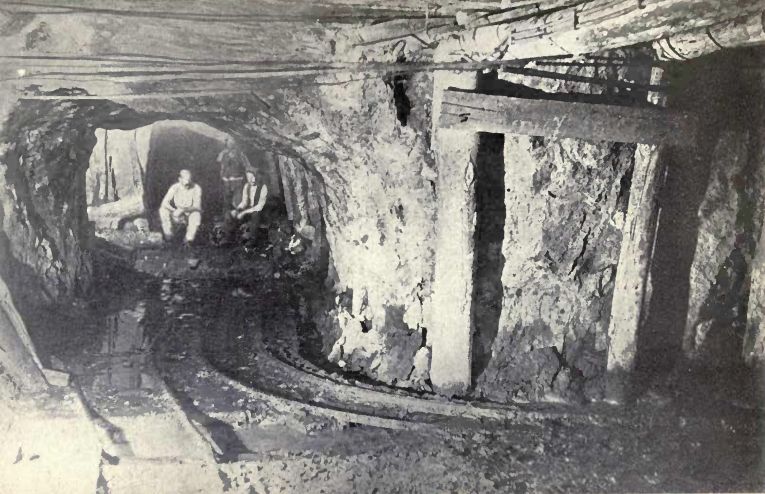 |
| Underground Diamond Mining |
Rough diamonds are, at best, translucent and their beauty is not
evident until it is released by cutting the stone. Diamond cutting was
introduced into Europe from India, in 1295, and the technique was improved,
almost two hundred years later, by Louis de Berguen of Bruges, who substituted
polishing with corundum powder with diamond dust.
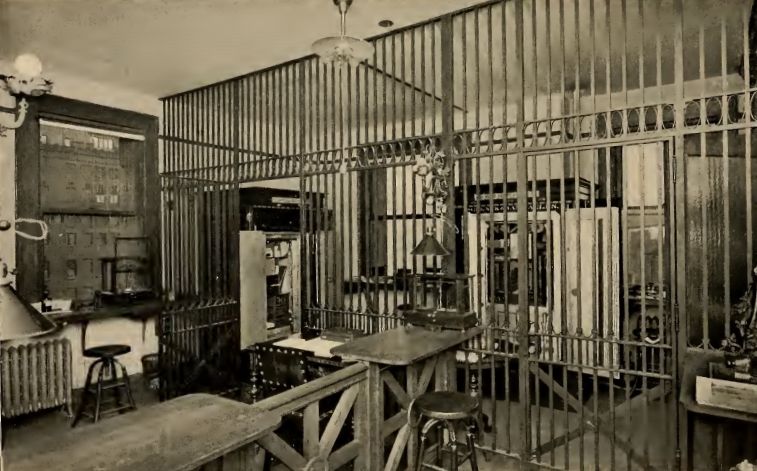 |
| Diamond Cutting Office |
In the seventeenth century,
Vincenzio Peruzzi of Venice produced the first brilliant cut diamond, with
thirty-three facets, or faces, above the girdle of the stone and twenty-five
below. The rough stone is held in a cement or soft solder mount as each facet
is cut and polished, and remounted for each individual facet, which are
generally triangular or quadrangular in shape.
 |
| Diamond Cutting |
The work is carried out over a
small strong box, which serves to catch the resultant abraded powder and
fragments, known as bort. The process is both skilled and
time-consuming, particularly before mechanical methods were developed with, for
example, the Regent diamond taking two years to cut in 1712 (at a cost of
£5,000) and the Koh-i-noor was recut in 1862, taking thirty-eight days, at
twelve hours per day, costing £8,000 in labour.
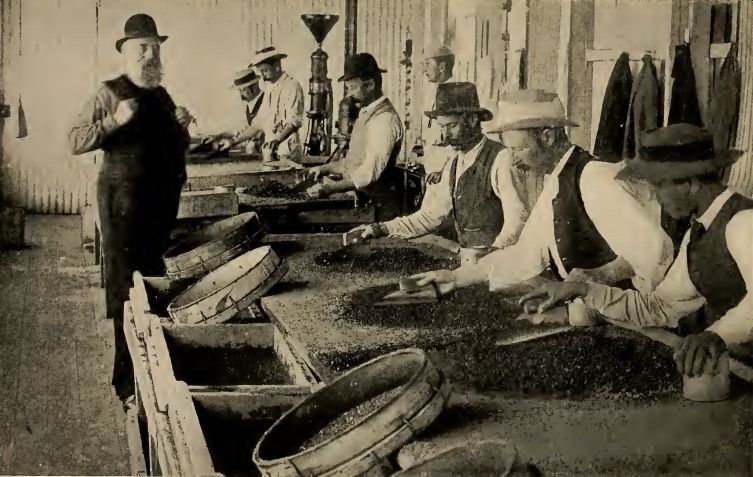 |
| Sorting the Silt for Diamonds |
Brilliant cut diamonds command
the highest prices, followed by Rose cut and Table cut gems, and the colour of
the stone also affects its value, with blue-white diamonds being the most
valuable, followed in order by blue, red, green, white, olive, black, fire
coloured and yellow. A coal black stone of 350 carats, which was so hard it was
impossible to cut, was exhibited to great interest at the Great Exhibition in
London, in 1851.
 |
| Diamond Cutting |
Rough diamonds are examined by experts, who use their skill to
decide how the stone can best be cut with a minimum loss of size, before
marking it for sawing or cleaving to remove the excess areas. The part of the
stone which will provide the table is then decided on, this is the
largest facet of the diamond, usually situated on the top of the stone, and the
facets surrounding the table are then cut away, in a process called bruiting.
 |
| Diamond Polishing |
The diamond is then polished, on a wheel, using a combination of diamond dust
and oil, until the required finish is achieved. There is no such thing as a
‘perfect’ diamond, as they all contain minor imperfections, called flaws
or feathers, caused by intruding carbon atoms or minute cracks, but for
practical purposes, ‘perfect’ stones are those that lack any flaws or spots
that can be seen by a person with ordinary sight using a watchmaker’s
magnifying glass.
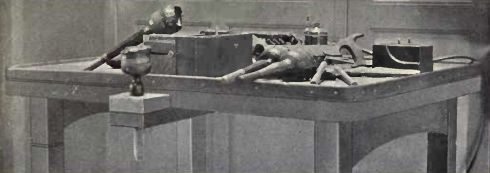 |
| Diamond Cutting Tools |
The value of a diamond is said, popularly, to rest on the Four
Cs – colour, clarity, cut and carat. The carat is the weight of the
stone, set in 1907 as the metric carat of 200 mg of mass, but formerly four
grains Troy weight, later set at just below four grains, the name thought to
come either from the Italian caratáre – to weigh with great care, or the
French caret – it is wanting, in reference to the tiny margin below the
four grain measure.
There is little evidence that folk etymology of the name
being derived from kuara, meaning a carob bean, is the true origin of
the term. The price per carat per stone is not linear, as larger stones are
rarer and thus demand a higher price per carat as the carat mass increases, and
prices are also affected by the demand for certain carat weight stones used in
jewellery manufacture.
Tomorrow – A Famous Diamond.

No comments:
Post a Comment